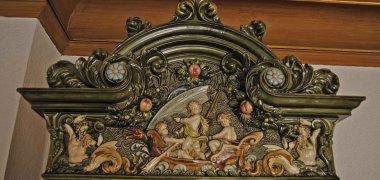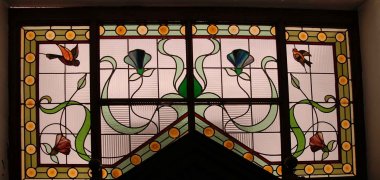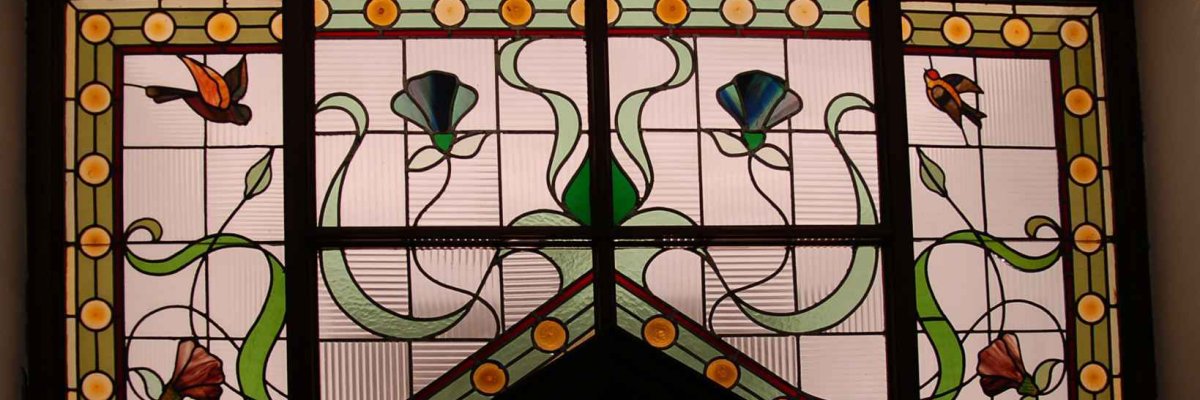The Uhl'sche Haus in Göllheim
There is a very special building in Göllheim: the Uhl'sche Haus.
There you can learn a lot about the history of the place and about the lives of people in earlier times.
One focus of the exhibition is the Uhl family.
Wilhelm and Babette Uhl had the house built at Hauptstraße 7 in 1898.
It is a large residential building with a mansard roof, built in the Wilhelminian style.
The richly decorated façade shows how splendid and elaborate the building was.
The family's affluent lifestyle can still be seen inside today:
There is leather-like embossed wallpaper, painted ceilings, Art Nouveau windows and elaborately designed tiled stoves made of faience - a fine, glazed ceramic.
All these elements show how the Uhl family lived at the time and the value they placed on beautiful things.
Wilhelm Uhl was mayor of Göllheim for 16 years. After the death of Wilhelm and Babette Uhl, the house was sold to the municipality. It has been a local history museum since 1979 and displays the history of Göllheim.
A few years ago, the Uhl house was modernized and expanded with a new concept.
Another major theme in the museum is the Battle of Hasenbühl. This battle took place in 1298 at the gates of Göllheim and was the last battle of knights on German soil. In the battle for the crown, the German King Adolf von Nassau lost to his opponent Albrecht von Habsburg and lost his life in the process.
A large diorama with many painted pewter figures and an audio station allow visitors to experience the dramatic battle up close. If you want to experience what it was like to be a knight, you can put on a helmet and a sword and put yourself in that role.
Another section of the exhibition deals with archaeology in and around Göllheim. Here you can see how the first inhabitants of Göllheim lived around 7,500 years ago. The exhibition also shows what traces the Romans left behind and what items the Merovingians placed in the graves of their deceased.

The geology around Göllheim is closely linked to the Dyckerhoff cement company. On the Dachsberg near Göllheim, the company mined lime marl for many decades - an important rock for the production of cement. The former mining area has since become a geopark, which is now open to visitors.
The exhibition in the Uhl'sches Haus tells the story of the Göllheim lagoon, which existed in this place millions of years ago.
The so-called limestone snail from the Tertiary period is also explained - an indication of how old and special the rock formations here are. Another part of the exhibition is dedicated to cement as an important building material with a long history.
A particularly interesting piece of information:
In 1886, Dyckerhoff supplied a total of 8,000 barrels of Portland cement for the construction of the Statue of Liberty in New York - an impressive example of the company's international importance.

The fifth exhibition area in the Uhl'sches Haus is entitled "The Fascination of Dolls" and fits perfectly into the upper-class ambience of the historic building.
The exhibition shows how elaborately and lovingly dolls were designed in the past and why they still fascinate many people today.
But the Uhl'sche Haus offers much more:
In addition to numerous historical objects, there are audio stations, documentary films, hands-on projects and a small café that invites you to linger.
There is a very special room on the first floor:
The former reception room of the Uhl family with its elaborate wood paneling and painted ceilings can even be used for weddings today.
It offers a stylish and festive atmosphere for special occasions.
Here you can find the website of the Museum Uhl'sches Haus
You can also experience the museum virtually: 360 degree tour - Museum Uhl'sches Haus
